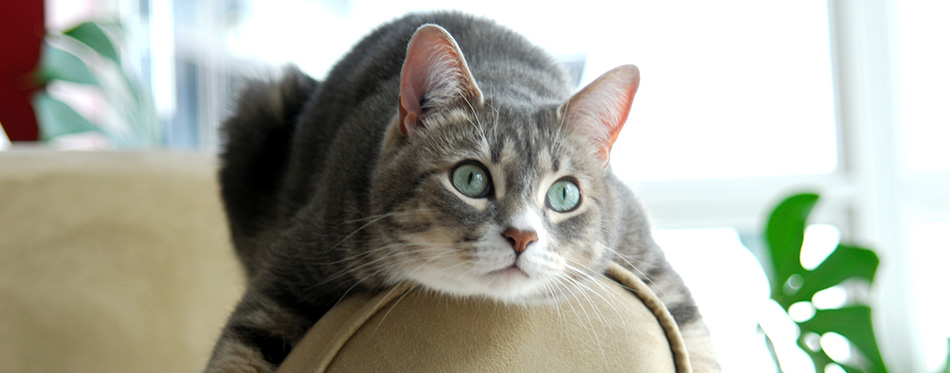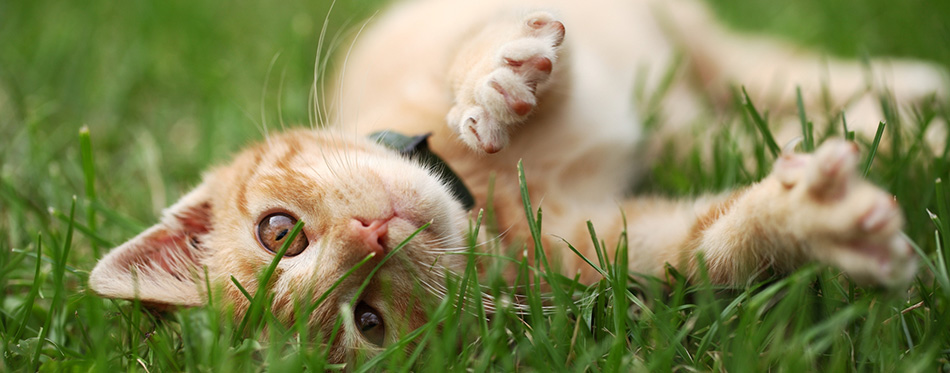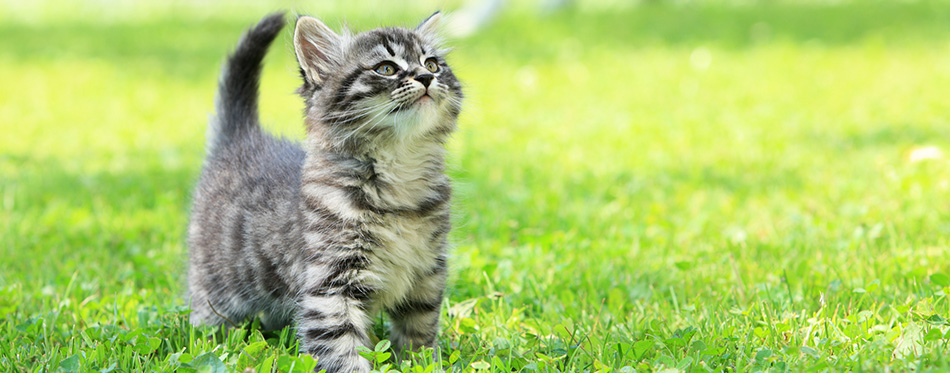Seeing your cat on catnip might be one of the funniest moments of being a cat parent. Out furry little felines are funny enough in their own rite, but after some catnip, their behavior can become exaggerated, like a caricature of their usual self. Just search for ‘Cats on Catnip’ on YouTube and you’ll find a goldmine of videos showing cats experiencing complete euphoria from this powerful substance!
Despite its ability to relax cats and make them more playful, many people have concerns over the use of catnip as it is often referred to as a ‘drug for cats’. If you’re considering buying this for your cat and have some questions or concerns, let’s answer them in this ultimate guide to catnip.

What is Catnip?
Catnip, otherwise known as Nepeta Cataria, is a type of mint plant that grows all over the world. The plant has little bulbs covering its leaves which contain nepetalactone, a menthol smelling liquid which is produced as an organic byproduct. This liquid is the chemical responsible for your cat’s reaction to catnip as it clings to receptors in cats’ noses when sniffed. When the chemicals adhere to the receptors, a signal is sent to the brain which alters certain neurological pathways, resulting in the animal’s changed behavior. The way catnip affects the brain and its ability to change behavior is the reason for its popular comparison to a drug. However, it doesn’t affect our feline friends in the same way drugs can affect humans, but we’ll go over that further later on. Since using catnip involves sniffing particles into the nose, it is advised that asthmatic cats don’t use catnip as it may cause further respiratory problems.
So, now we know what catnip is and where it comes from, but we haven’t discussed how your cat can use it. Catnip comes in many forms which makes it easier for you to choose how you want to use it and how it might best suit your cat’s needs. In most pet stores you can buy soft toys that are stuffed with leaves from the catnip plant, making them even more fun for your playful pet. Catnip can also come as a spray or oil which can be used (sparingly) on soft toys, furnishings, scratch posts or blankets, but just be careful not to use too much! Although catnip isn’t harmful and is a safe substance to keep your cat entertained or relaxed, too much at once can cause some side effects like dizziness, sickness or diarrhea. Most importantly, don’t let your cat eat/drink catnip as this can cause varying degrees of responses. While some cats won’t be affected at all, others can become aggressive or ill, so it’s best to use this as a scent only. As with any new substance you’re introducing to your cat, we recommend asking the vet first for advice tailored to your cat specifically.
Is Catnip a New Thing?
Scientists and cat experts generally agree that catnip was first used by the Ancient Egyptians as an offering to the cats they worshiped. In Egyptian art, cats were often depicted near long green plants which are believed to be the catnip plant, suggesting the euphoric powers of this plant had already been discovered. As Nepeta Cataria also originates from the Middle East it seems even more likely that the Egyptians would have grown and used this plant as depicted in their art.
Although it is likely to have been continuously used after the Ancient Egyptians, the catnip plant was only first documented in 1738. Following its first documentation, the use of this powerful plant grew exponentially and was used not just to calm cautious kitties, but also by humans as a natural remedy to minor ailments. Leaves from the plant which contain the active liquid in catnip (nepetalactone) have been used by humans as a mild sedative to aid recovery. In order to acquire these healing properties, the leaves would either be used for herbal tea or smoked. Along with medicinal uses, the plant was briefly used as a replacement for marijuana during the 1960s, however, its results were varying and unreliable. Although it provided a ‘high’ for most people, it did not become a popular drug as the responses were erratic and unpredictable. Nowadays, catnip is mainly used as a treat for your playful pet to calm their nerves or to help them become a more confident kitty.
Related Post: Cat Calming Sprays
So, What Does Catnip Actually Do?
Firstly, it’s estimated that only 50-70% of cats actually react to catnip while the remaining percentage have no response to it whatsoever. The cats that experience the effects of catnip, however, typically react in the same way so their response is mostly predictable…but still hilarious.
The typical responses to catnip include exaggerated purring, licking and rolling top-over-tail in complete feline-frenzy. Cats also typically become more affectionate and playful toward their owners during this time, but not always with other cats. If more than one cat is ‘under the influence’ at the same time its best to monitor their behavior in case of any problems. It’s also important to note that young kittens under 6 months should be kept away from products containing catnip as they usually don’t react well until adulthood.
The effects experienced from catnip don’t typically last too long, usually between 5 to 10 minutes. After this time your cat will return their usual self and will become immune to the substance for roughly 30 minutes – although this time varies greatly depending on the individual animal. It’s generally not a good idea to give cats catnip too often, although it isn’t addictive, it can cause some minor health problems if they are given it too much. But if you follow these steps and consult your vet with any questions, your furry friend will have a safe and fun-filled time using catnip!

Where to Buy Catnip
Originally catnip was only found in the Middle East and parts of Central Asia but now, thanks to its international popularity, you won’t have to look very far to find it. Catnip grows all over the world now and is one of the most readily available cat products you can find. In fact, most pet stores and even some supermarkets sell catnip in many forms. (We’ll cover all of the ways to use catnip in just a moment.)
Catnip can also be grown in most climates as long as there is some natural sunlight. Many pet owners grow their own catnip from home. You can buy seeds or ready-grown plants and keep them to use whenever you wish. If you decide to grow your own, it’s best to put them somewhere sunny and out of reach from your feline friends, maybe a windowsill or in your garden/greenhouse. Whenever you want to use some, simply cut off some leaves and chop them up so you can sprinkle them on your cat’s toys or bedding. Alternatively, you could squeeze out the liquid using a pestle and mortar to lightly cover a toy or to rub on a scratching surface.
Of course, buying catnip is also possible online and might be the easiest option depending on where you live or your choice of pet stores nearby. Like in most pet stores, you’ll be able to find a variety of catnip items available so you can choose what type of product might suit your cat based on their behavior.
How to Use Catnip
As we’ve mentioned, catnip comes in different types and choosing the right one could mean the difference between your cat’s slight enjoyment or fun-filled frenzy. But rest assured, there are small toys and amounts of catnip you can buy to see if your cat reacts positively (i.e hilariously). If you get a good reaction, then you’ll know it won’t be a waste to invest in a larger amount or more catnip toys.
You might be wondering what type of catnip is best to buy so let’s have a look at the options!
Stuffed Toys: These options are great for most cats and are generally the preferred option. They’re just like normal toys you would buy but they have catnip leaves stuffed inside to make them irresistible! They come in all shapes in sizes so you can choose the perfect toy to suit your perfect pet and, because they’re so popular, you’ll find them in most pet stores.
Herbs: These catnip herbs are another popular option because you can do so much with them! You can stuff them into a toy that your cat is already familiar with or you can sprinkle them over specific objects or toys your cat likes to play with. So, if your cat loves to scratch a post, or roll in cozy blankets, then they might enjoy it even more after you’ve sprinkled some of this special stuff all over it.
Catnip herbs can be bought either fresh or dried. Both types work very well but the dried herbs have the added benefit that they don’t have to be used quickly. Fresh herbs, once cut, will only maintain their potency for a short while so they have to be used promptly. But if you buy fresh herbs which are pre-cut, or you but a catnip plant and cut too many leaves, just pop the leftovers in the refrigerator or freezer until you need them again. This will ensure the key ingredient, nepetalactone, stays active.
Oils/Sprays: This option is a great choice for cat parents who want the versatility of catnip herbs but don’t want the hassle of cutting or freezing anything. Just like herbs, these can be sprayed on cat toys, scratch posts, bedding or any other object your cat likes to play in. Although these products are hassle-free and more versatile than other options, many customers feel that the scent does not last particularly long and isn’t very strong. However, if you don’t plan to use catnip very often and you don’t mind the slightly shorter ‘high’ your cat might experience then this option is ideal!
Prices vary between $2 to $7 for a small toy while larger toys and tubs of pre-cut catnip leaves range from about $8 to $20, depending on the size. Starting with a small-sized toy or tub of herbs might be a good decision as a first introduction to this euphoria-inducing substance, then you’ll know if a larger size will be worth it. If it works as expected, then you may wish to buy a larger amount or maybe even a fresh catnip plant. These plants can be grown in sunny areas within your house like a windowsill or can be grown outside if you have space for potted plants. Afterall, catnip is a type of mint plant and grows just like any other herb plant. Just make sure no cats can get access to the plant as you don’t want them stealing your catnip or getting ‘high’ while strolling through the garden!

What About the Cats that Don’t Experience the Effects of Catnip?
So, we’ve just learned what catnip is, how it works, and how to use it safely. But what about the cats that don’t feel the effects of catnip? Is there an alternative?
As we’ve mentioned, anywhere from 30-50% of our feline friends don’t experience any kind of reaction from catnip but don’t worry, there are a few alternatives that might just work. Silver vine, valerian root and tatarian honeysuckle are all plants with similar qualities to catnip and can be found in every corner of the world. Although these might not be as readily available as catnip, it may be worth searching for if you want to give your precious kitty a little treat!
By now you should be a pro at catnip, knowing what types to use and what behaviors to look out for. Simply follow this guide and consult your vet about any concerns you might have to keep you and your playful pet safe. And most importantly, enjoy seeing your furry friend as they experience a funny kind of euphoria!
Sources:
- FELINE FINE: THE BENEFITS OF CATNIP – Texas A&M University
- Crazy for catnip – The Humane Society of the US

